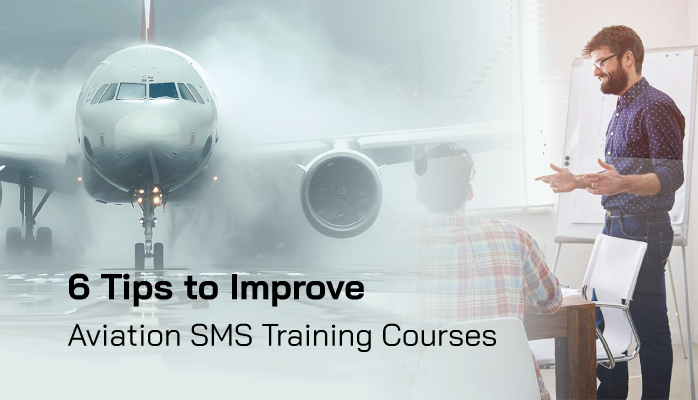The Real Goals of Aviation SMS Training

Organization’s with successful aviation safety management systems (SMS) training strategies universally have very well performing aviation SMS. End of story.
Training can make or break a company.
And let’s be honest, 99% of all training courses you or I have ever attended were dreadfully boring, uninspiring, and (worst of all) forgettable.
There are really only two main goals for training to change. The first goal of aviation SMS training is preparing individuals for how to act safely in all situations, be it
- a mindset,
- an awareness, or
- a particular procedure of action.
The second reason for aviation SMS training is in response to changes in the operating environment. Aviation service providers' environments - i.e., procedures, technologies, policies, etc. – are always changing, and training is an attempt to “keep up.”
Related Articles on Aviation SMS Training
- SMS Chart: Where to Focus Hazard Identification Training & Risk Mitigation
- Understanding Role of Hazard Identification Training and Safety Reporting Forms in Aviation SMS
- What Is Aviation Safety Training in Aviation SMS - Includes Videos to Use
Lack of safety training always results in a lack of preparedness. Incorrect actions because of unpreparedness can have devastating safety and financial repercussions. Getting the following areas of safety training to stick in employees' minds is difficult:
- Concepts;
- Procedures; and
- Rules; and
- Philosophies.
To make sure your employees don’t forget 90% of their training after 1 week (which is, by the way, the average), here are 6 tips.
1 – Give Incentives for Safety Training
Talk about setting up a safety training session for failure: employees feel like they are only doing the training because they have to.
While initial and recurrent SMS training does require employees to participate because they have to, that doesn’t mean employees can’t feel that they have some reason to be there.
Incentives are powerful in aviation SMS just as they had been effective in traditional safety programs. During SMS training, here are some incentives we have personally seen that proved to be extremely effective:
- A reward system for employees who score well on an initial training test (after the training or at a date soon after);
- A reward system if the employees as a whole perform certain training requirements well enough;
- Have a hierarchy of training “levels”; and
- Competition-based training, where prizes were given to top-scoring employees.
Many aviation SMS implementations, in general, don’t perform well simply because their employees don’t have safety incentives. Incentives don't have to cost much money to be effective. Ideas to motivate employee participation in SMS training may include:
- Gift cards;
- Company swag;
- Certificates of completion.
Certificates of completion as an incentive may work, but not in all cultures. In the United States, certificates are not as valued as highly as in:
- Latin America;
- Africa; and
- Middle East.
There are cultures where employees collect certificates for a sense of personal accomplishment. Other cultures may see certificates as nothing more than:
- I attended;
- I survived; and now
- All I have is this piece of paper that will mean nothing in six months.
You have to be careful about choosing incentives that actually have some value to employees. If certificates are handed out like Halloween candy at your company, I wouldn't use certificates to motivate employees to either attend or actively participate in the required SMS training.
Related Articles on Aviation SMS Training
- Best Ways to Automate Aviation Safety Training for Initial/Recurrent Requirements (Free Resources)
- Safety Chart: How Effective Is Hazard Identification Training in Aviation SMS?
- 4 Pillars | 10 Things You Need to Know About Aviation Safety Training
2 – Making Safety Training Interactive

Aviation SMS are ultimately systems that depend on community and involvement. I firmly believe that training courses should be modeled after this fact. Too often safety training courses involve
- sitting in a chair,
- taking “notes,”
- checking your email occasionally,
- surfing the web whenever possible,
- checking boxes, and
- answering black-and-white, boring questions that aren’t realistic to real-life situations at all.
Interactivity in aviation safety training means incorporating
- group discussions,
- videos,
- games,
- hands-on exercises; and
- role-playing in challenging real-life scenarios.
Simply put, interactivity is about teaching safety training materials by having employees do something other than “just sit and listen.”
Of course, the reason why more SMS training courses aren’t interactive is that:
- Additional training time consumes operational budgets;
- Creating interactive training materials takes extra time and effort;
- Management prefers employees engaged in production activities; and
- Managers are afraid of making the interactive training “stupid” or “silly,” so they instead stick to the traditional, boring training.
Safety training that is interactive will be memorable. Aviation SMS implementations choose to go the extra mile, will make a big difference in proactive hazard identification activity levels and subsequent risk management efforts. If there were any part of SMS training that should be repeatedly stressed and made interactive, I would recommend that you make the hazard identification training sections interactive.
Hazard identification training should be included in the SMS. There is the boring training routine of simply throwing up a few slides about hazard identifications and pictures of aircraft accidents. How many of you have seen this until your eyes glaze over? There are some very good opportunities to engage employees in the hazard identification sections of your training. After all, this is what you want employees to focus on when they are interacting with operational "systems."
Employees are the eyes and ears of operational safety assurance. They need to be well-versed in:
- Hazards;
- Risks and hazard related consequences; and
- Risk controls - how they work, how to identify when they are not working.
Furthermore, is there any better "low-hanging fruit" for making training interactive than hazard identification training?
Related Articles on Aviation SMS Training
- Why Initial SMS Training Is So Crucial for Risk Management Programs
- Why Employees Can’t Stand Aviation SMS Training
- Most Common Misconceptions About Aviation Risk Management Training
3 – Condense SMS Training Materials
The time required to finish a mandatory SMS training course may be overwhelmingly long, by the end, most people will cut any corner to be finished with it. SMS training courses don't have to be long and boring. Successful industry practices that we have seen are safety managers who condense their training materials in several ways:
- Break up training into smaller “units”;
- Provide online training that can conveniently fit employee schedules;
- Redirect some training energy toward non-traditional training media, such as newsletters and safety surveys; and
- Condense the overall scope and size of the training material as a whole.
Making training segments smaller, more spread out, and easier to digest will ensure that completing safety training is much less of a headache for employees. Furthermore, short, meaningful training will positively affect safety cultures, while the boring type of safety training I've sat through time and again makes me very lukewarm about the company's safety program.
4 – Focus on Individual’s Safety Roles

Creating custom training content that is tailored to specific safety roles in your aviation SMS is superb for addressing some of the other tips, namely:
- Greater incentive: employees will be more interested if training relates directly to themselves;
- More interactive: employees will feel more involved in the training is specifically addresses their needs; and
- Opportunity for story-based training: can create scenarios around each position.
Basically, the main point here is to make training material relatable and familiar. As in, relating material to scenarios that are familiar to each role’s
- actual experience,
- actual responsibilities in the program, and
- actual relationship to other positions in the safety program.
Related Articles on Aviation SMS Training
- Training Management in Aviation SMS
- How to Deliver Online Aviation SMS Training Meeting SMS Objectives - With Templates
- 3 Critical Topics for Aviation SMS Training to Focus On
5 – Story Based Training
We could also call this tip “Scenario training.”
The safety reality of the work environment is often messier and requires a much greater interpretation than would be indicated in most
- procedures,
- policies, and
- rules.
Employees who are only trained on what the material is and not what it looks like in real-life practice will be under-prepared for using the training material in real-life situations.
Training materials should use real-life stories and scenarios to illustrate training points because:
- It puts the training material into context;
- It makes the training material more relevant; and
- Makes training seem more personal and useful.
Sometimes training can seem pointless – as in, “I’ll never need that.” Using real-life scenarios shows with examples the reason for any particular piece of training.
6 – Mix Up Training Materials
Recurrent training is a mainstay for any aviation SMS implementations. Seasoned employees will have been through many of the same aviation SMS training courses as years pass by. That becomes tedious very quickly.
A very good idea is to periodically make changes to the training materials so that employees don’t tune them out. These changes can be simple but effective alterations to:
- Scenarios;
- Wording; and/or
- Visual presentation.
Doing all three changes to training materials takes little time but makes the material look and feel entirely different.
Related Articles on Aviation SMS Training
- How to Use Aviation Safety Articles for Recurring SMS Training Requirements
- How Recurrent Aviation SMS Training Makes Good Business Sense
- When Employees Need More Hazard Identification Training - Aviation SMS
Final Thought: Assessing the Effectiveness of Aviation SMS Training
Aviation SMS managers may put tremendous effort and time into creating training materials for employees. But that doesn’t make the material good. Ultimately, it’s what employees think of their training courses that count. Figuring out what works and what doesn’t work for your aviation SMS training is about:
- Using safety surveys to get trackable opinions and comparing results to particular training methods;
- Asking individual employees what they liked and didn’t like; and
- Judging involvement, interest, and reactions during the training.
The best SMS training for safety managers is automated training given to all employees. This holds true for especially the required initial and recurring reactive risk management training for Phase 2 SMS implementations.
If you cannot automate it, here is the next best thing. Start with a template so you don't have to recreate the wheel.
Last updated December 2024.








